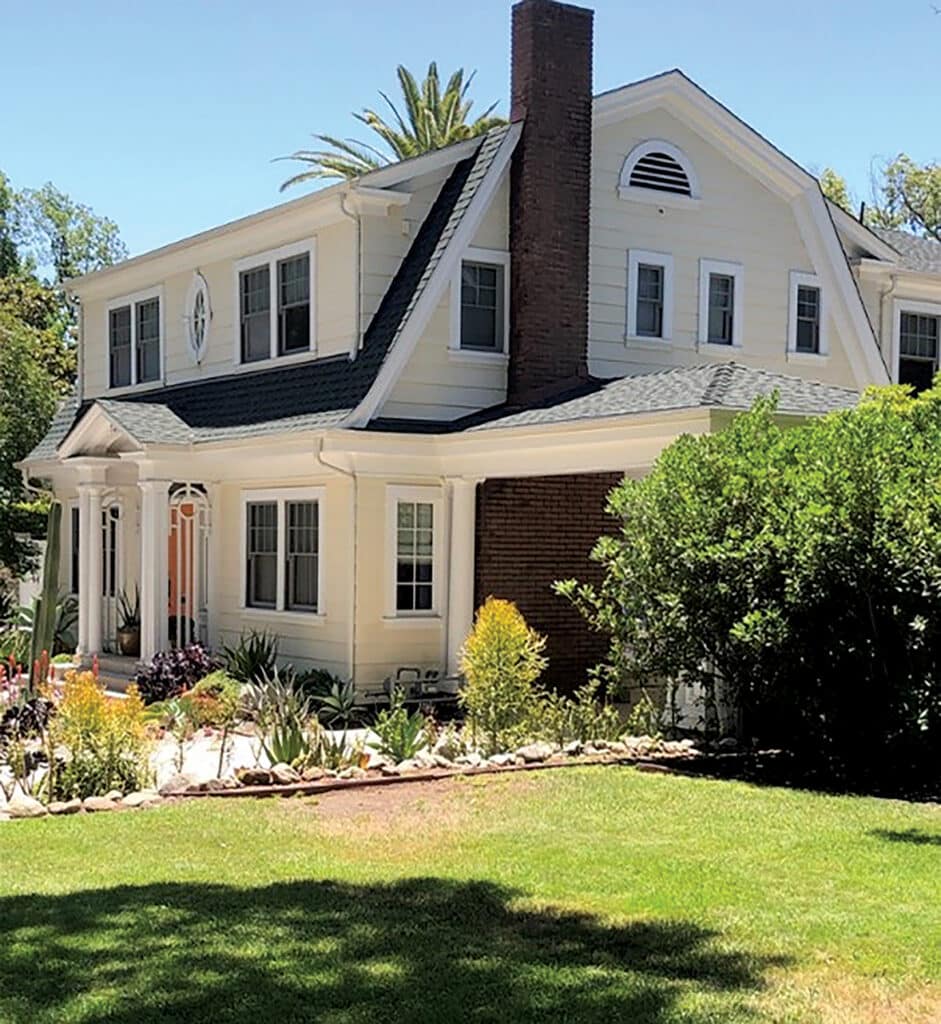Architectural styles: turn of the century

by John Neiuber | Special to the Courier
“Turn of the century” is a term used to describe a group of residential styles popular from the late 1880s through the 1910s. The rapid industrialization that occurred during this period, the mass production of building products, and the new transcontinental railroad (completed in 1869) made these easily replicated styles popular.
Turn of the century styles flourished from 1900 to 1918 in Claremont and include the Victorian styles, massed plan vernacular, shingle style, American Colonial Revival, one-story bungalows, and American Foursquare. These styles have some similar characteristics, including simple forms, single story front porches, predominantly double-hung windows, and wood exterior materials. However, each style is slightly different. In this installment we will explore two of the styles of turn of the century architecture.
One of the most dominant styles of turn of the century homes in Claremont is the one-story bungalow, built in the early 1900s. The styles vary from those that contain simplified Craftsman details to those with classical details of the California Bungalow. Many have detailing unique to Claremont. The term “bungalow” originated in the Bengal region of India and came from a native hut called a bangala, which was described as a comfortable, single-story home with high thatched roofs and overhanging eaves that provided much needed shade. In the late 1800s the term was used to describe summer vacation cottages in the U.S. At the turn of the century, the term came into wide use by leaders and architects of the Arts and Crafts movement. Eventually, it came to describe simple one-story homes, of many different styles.
In early 20th century California the style developed as an efficient and much less expensive home than the complex and costly Victorian houses. It suggested a simpler, informal style of living. Usually a one-story rectangular-plan house, often with individual detailing in pedimented small porch entries, Claremont has many of these simple wood or stucco bungalows that preceded the larger and more detailed Craftsman bungalow styles.

Colonial Dutch Revival: this high style Colonial Dutch Revival house has dormers and symmetrical placement of architectural features. Photo/John Neiuber
Character defining features – one-story bungalows
Massing
- Simple rectangular plan and massing, usually one-story.
- Flat facades with projecting portico at covered front entry. Central front entry door.
- Covered front porch.
- Garages where present are detached at the side-rear yard.
Roofs
- Side gable, or hipped roofs, occasionally with:
- Medium pitch;
- Wood or composition shingles;
- Boxed eaves;
- Cornice board or frieze;
- Cornice returns at gable ends.
Porches
- Front entry doors are usually centered and accentuated by a decorative, pedimented covered entry.
- Partial or full-width one-story porches may exist in some examples.
- Porches often have classical columns.
- Porch roofs are usually simple pedimented gables, or flat half round elements with small balustrades.
Architectural details
- Symmetrical placement of architectural features.
- Classical columns at covered entry porticos.
- Simple brick chimneys at the gable ends.
- Horizontal wood siding.
Windows and doors
- Round, half-round or quatrefoil windows at gable ends.
- Double-hung wood windows with multipaned, true-divided lite sash.
- Wood paneled doors, occasionally with sidelights and fanlights.
Another style found widely in Claremont is the American Colonial Revival, which was the dominant style for residential construction throughout the country from 1880 to 1955. Colonial Revival homes represent a resurgence of interest in the early English and Dutch houses built along the Atlantic seaboard. Usually two-story and rectangular in plan and massing, Colonial Revival homes have side gabled, gambrel, or hipped roofs, wood or brick exteriors, and a symmetrical arrangement of windows and doors on a flat facade. Characteristic features include an accentuated front door, normally with a decorated pediment supported by pilasters. Overhead fanlights or sidelights are also commonly found with the entry door. In Claremont, Colonial Revival homes range from the simple Cape Cod saltbox to more high-style Colonial Revival homes.
Character defining features – American Colonial Revival style
Massing
- Simple rectangular plan and massing, occasionally L-shaped two stories.
- Flat facades with projecting portico at covered front entry Central front entry door.
- Covered front porch.
- Garages where present are detached at the side/rear yard.
Roofs
- Side gable, gambrel, or hipped roofs, occasionally with gabled dormers, usually in pairs or groups of three.
- Medium pitch.
- Wood or composition shingles.
- Boxed eaves.
- Cornice board or frieze.
- Cornice returns at gable ends.
Porches
- Front entry doors are usually accentuated by a decorative, pedimented covered entry.
- Partial or full-width one story porches may exist on older examples.
- Smaller porticos are common in later examples.
- Porches generally have classical columns.
- Porch roofs are usually simple pedimented gables, or flat half round elements with small balustrades.
Architectural details
- Symmetrical placement of architectural features.
- Small decorative balustrade at top of entry porticos.
- Classical columns at covered entry porticos.
- Simple brick chimneys at the gable ends.
- Horizontal wood siding.
- Brick exterior walls (not common in Claremont).
Future installments will explore additional turn of the century styles found in Claremont.








0 Comments